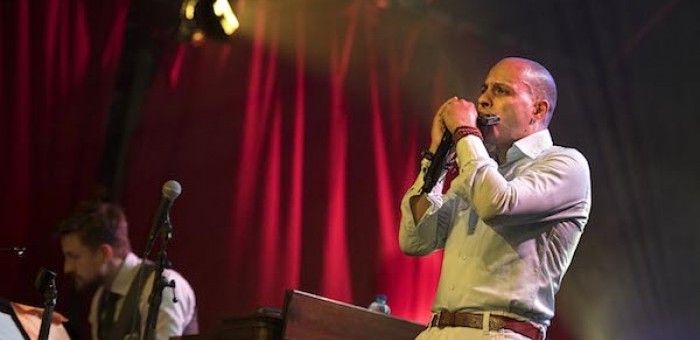Apr 2, 2024 12:59 PM
Saxophonist, Sonic Explorer Casey Benjamin Dies at 45
Casey Benjamin, the alto saxophonist, vocalist, keyboardist and producer who stamped his distinctive sounds on the…

Ondrej Pivec (left) and Grégoire Maret perform at the North Sea Jazz Festival in Rotterdam, The Netherlands, on July 10.
(Photo: Steven Sussman)Even though he’s still riding the crest of his latest recording, Wanted (Sunnyside), harmonica virtuoso Grégoire Maret arrived at the North Sea Jazz Festival in Rotterdam, The Netherlands, on July 10 with a very different repertoire, using the stage to share with the audience a brand new project called “The Gospel According to Grégoire Maret.”
The set at the open-tented Congo venue was electrifying, soulful, smooth and spiritual as Maret led his groove-oriented nine-piece ensemble (with a heavy emphasis on vocals) with an ecstatic delivery. A sonic shape-shifter, he used his harmonica to warp through a range of sounds, recalling at times a dark tenor saxophone, at others a high-pitched oboe.
The chromatic harmonica maestro opened a new orchestral world of colors, rhythms and harmonies at his packed North Sea show, which opened with the appropriately titled “Groove.” He arched his body into rhythmic blowing, bending low then rising up as drummer Marcus Baylor pushed the music ahead. It was a fiery opening that drew more people in to check out the source of the onstage excitement. And it was a new style of worship, too, with vocal choir, churchy organ and big beats that would rock any Stateside church with ease.
While he originally made his name as a sideman—alongside such giants as Herbie Hancock and Pat Metheny—Maret has been building an impressive resume as a leader, especially with his new gospel project, a joint endeavor set into motion with keyboardist Shedrick Mitchell and Baylor (both of whom attended The New School with Maret back in the day); Baylor’s wife, vocalist Jean Baylor; and arranger/vocalist Stephanie Fisher.
The ensemble, which is about a year-and-a-half old, figures prominently into Maret’s plan for a recorded trilogy that includes Wanted and a collection of songs exploring the prison system, which he says “makes for a form of slavery, especially for black people.”
The new gospel project abounds with a sense of freedom, which Maret said he wanted to manifest now, given the state of chaos in the political arena. He noted in a Talking Jazz session after the show, “Historically when black folks become oppressed, one of the only means to break the chains and feel free is through the music—and gospel in particular.”
While the bulk of his music is instrumental, for the gospel project Maret said he wanted to write songs with strong melodies and chord changes, which he spent months perfecting. But when it came to lyrics, he begged off. “It’s something I just can’t do,” he said. “So that’s where Jean and Stephanie came in. And Stephanie is a choir master at her church, so she put together the arrangements.”
Maret’s rendition of gospel steers clear of preaching and evangelizing, but is instead gospel-esque; it emphasizes organ and choir, with tempo accelerations and harmonica lines weaving together with the vocal harmonies. (With the exception of Fisher, singers were enlisted from Britain, including Kersha Bailey, Monique Meade and Raffaele Crolla.) Mitchell, a church organist, missed the gig but was replaced by one of his protégés, Ondrej Pivec, who pumped juicy phrases on the Hammond B-3.
While another Brit, Zara McFarlane, was featured as a guest singer, her performance was overshadowed by Crolla, a late addition whom Maret had met only two days before the show. On “Lullaby,” a concert highlight, Crolla sang with r&b gusto while Maret played off of him with a powerful lyricism.
Another highlight came at the end of the performance, with the song “Free,” an old Maret instrumental that had been shelved but came to new life with Jean Baylor’s lyrics. The tune starts in a floaty zone before a speedy beat kicks in, spurred by Maret’s bent notes. Marcus Baylor charged in at high volume, and he and the leader engaged in a crashing, tumbling and driving dialog that served as the tune’s—and the show’s—climax.
“The Gospel According to Grégoire Maret” was originally fine-tuned in small clubs around New York, then played to a big crowd at this year’s Winter Jazzfest in New York, where bookers began signing them up for shows. Maret will revisit the program in September at the Detroit Jazz Festival.

Benjamin possessed a fluid, round sound on the alto saxophone, and he was often most recognizable by the layers of electronic effects that he put onto the instrument.
Apr 2, 2024 12:59 PM
Casey Benjamin, the alto saxophonist, vocalist, keyboardist and producer who stamped his distinctive sounds on the…

“He’s constructing intelligent musical sentences that connect seamlessly, which is the most important part of linear playing,” Charles McPherson said of alto saxophonist Sonny Red.
Feb 27, 2024 1:40 PM
“I might not have felt this way 30 to 40 years ago, but I’ve reached a point where I can hear value in what people…

Albert “Tootie” Heath (1935–2024) followed in the tradition of drummer Kenny Clarke, his idol.
Apr 5, 2024 10:28 AM
Albert “Tootie” Heath, a drummer of impeccable taste and time who was the youngest of three jazz-legend brothers…

“Both of us are quite grounded in the craft, the tradition and the harmonic sense,” Rosenwinkel said of his experience playing with Allen. “Yet I felt we shared something mystical as well.”
Mar 12, 2024 11:42 AM
“There are a few musicians you hear where, as somebody once said, the molecules in the room change. Geri was one of…

Henry Threadgill performs with Zooid at Big Ears in Knoxville, Tennessee.
Apr 9, 2024 11:30 AM
Big Ears, the annual four-day music celebration that first took place in 2009 in Knoxville, Tennessee, could well be…